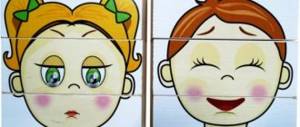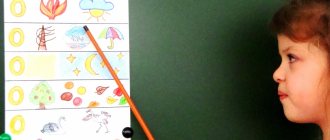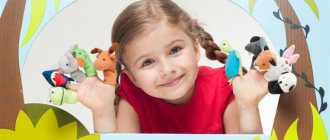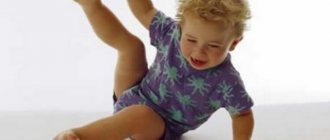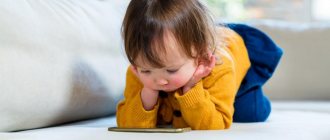What's happened
Social communicative development is the process of developing preschoolers’ communication skills with people around them (getting to know each other, the ability to hold a conversation, resolving conflict situations). This definition is very conditional, because many authors formulate it in their own way.
Child development is important from an early age
Educational field "Social and communicative development"
Note! This topic is extremely relevant today, because many children, despite being younger or older, experience difficulties communicating both with peers and with adults.
It can be difficult for them with peers:
- to set up a contact;
- join the game;
- Distribute roles in this game, conflicts often arise.
The problem with parents is the child’s inability to hear an adult and fulfill requests; uncontrollability is common.
Conflict resolution is also development
Tasks
The main goal of social and communicative development of preschool children is:
- instilling in them communication skills;
- introducing them to the traditions of the Russian family;
- mastering the rules of behavior in society;
- directing them towards positive communication.
The federal state educational standard defines the main tasks of the social and communicative development of children as:
- Development of independence in life and decision making.
- Increasing the time that a preschooler spends communicating with peers and adults.
- Development of empathy (feelings of compassion), responsiveness, willingness to make contact.
- Mastering the norms existing in society.
- Instilling hard work, developing creativity.
Experts often call the sixth task the development of determination, multitasking, and the ability to organize a technological process.
Meaning
Communication is one of the most necessary skills for living in society. Unfortunately, at present, for certain reasons, many children do not develop this skill sufficiently.
For your information! One of the reasons for this is parents who do not pay due attention to the child and are not involved in his upbringing.
It may also be due to health problems that interfere with the development of skills. As a result of insufficient development of communication skills, the baby has problems:
- he begins to experience difficulties in communication;
- cannot join the team;
- does not know how to work in a team;
- unable to express emotions correctly;
- cannot empathize.
Respect for elders must be instilled
Diagnostics
Before starting classes on the development of communication skills, as well as subsequently, it is important for teachers to diagnose the communicative development of preschoolers. It consists of conducting a conversation with children, observing them as they complete a task, using preschool didactic material. Communicative development is assessed according to three criteria:
- The child’s knowledge of the rules of communication with people.
- How willingly the child communicates.
- The extent to which a child can listen, resolve conflict situations, and how empathic he is.
Each of these three criteria is assessed using a point system, and as a result, communicative development is assessed at one of three levels: high, low or average. The teaching council approves assignments.
For your information! Based on the level of communicative development, additional work can be done with the preschooler to improve communication skills, and further activities can be planned.
From the experience of work “Social and communicative development of preschool children”
Modern society lives in a constantly changing world in the information age and the introduction of the latest technical means of information; the constant lack of time changes the usual norms and forms of intra-family and interpersonal relationships. Many parents believe that the intellectual development of a child is most relevant in the modern world of information technology. Teaching a child from an early age the latest technical means and developing certain skills that, in the opinion of parents, correspond to the requirements of today, should prepare the child for an independent life and make him competitive. In pursuit of new trends, parents forget that a competitive, capable person is not only intellectually developed, capable of solving intellectual problems of the modern world, but also a person successfully adapted to society, able to build interpersonal relationships, and having constructive communication skills. But modern parents do not pay due attention to these areas in the child’s development.
Therefore, one of the main directions of the kindergarten’s work with preschoolers and their families is to create conditions that facilitate the child’s successful adaptation to social reality through the development of social and communicative spheres of activity. This direction of work has been confirmed in modern educational innovations: Order of the Ministry of Education and Science of Russia dated October 17, 2013. No. 1155 “On approval of the federal state educational standard for preschool education.” The Federal State Educational Standard for preschool education determines the mandatory minimum content of the program, which is implemented in preschool educational institutions, so “Social and communicative development is aimed at:
- to assimilate the norms and values accepted in society, including moral and ethical values;
— development of communication and interaction of the child with adults and peers;
— formation of independence, focus and self-regulation of one’s own values;
— development of social and emotional intelligence, emotional responsiveness, empathy, formation of readiness for joint activities with peers, formation of a respectful attitude and a sense of belonging to one’s family and to the community of children and adults in preschool educational institutions;
— formation of positive attitudes towards various types of work and creativity;
— formation of the foundations of safe behavior in everyday life, society, and nature.”
Such special attention to the social and communicative development of a modern preschooler is due to the fact that this period of child development is one of the important stages in personality development. This is the initial period of a child’s socialization, his introduction to cultural and universal values, the time when intrapersonal and interpersonal relationships with adults and peers begin to be built. This time is also characterized by the accumulation of important experience of cognition, activity, creativity, comprehension of one’s capabilities and self-knowledge in a preschooler under the direct guidance of an adult.
Therefore, on the one hand, they need vivid emotional impressions, and on the other hand, games and exercises that help children learn to manage, correct, and realize emotions.
The social and communicative development of preschool children is multifaceted, complex and often delayed in time. Therefore, the goal of adults is to help children adapt to the modern world, which is characterized by complex, dynamic, negative experiences and manifestations.
The relevance of the formation of social and communicative skills of preschoolers at the pedagogical level is determined by the social order of society - the formation of a socially developed personality of the child. A sufficient level of development of social and communication skills, being one of the necessary components of a child’s readiness to learn, provides him with the opportunity to successfully master the school curriculum. The first society for a “little” person is the collective of the kindergarten group, and it largely determines the further path of his personal and social development. The experience of these first relationships is the foundation for the further development of the child’s personality and largely determines the characteristics of a person’s self-awareness, his attitude to the world, his behavior and well-being among people.
This is especially true nowadays, since communication is disappearing from a child’s life. Children spend a lot of time in front of the TV and computer, without paying enough attention to playing with their peers. The ability to communicate with each other is one of the necessary conditions for the normal personal and social development of a child. Poor speech leads to aggression, since the child cannot always express in words what he wants to say.
The dynamism of the sociocultural space requires modern man to act on flexible adaptive mechanisms, the formation and development of which begins already in preschool childhood. One such mechanism is the ability to communicate . Possession of communication skills allows a child to constructively organize interpersonal interaction with other participants and find adequate solutions to communication problems; it puts him in the position of an active partner and, as a result, allows him to “find himself” in a group of peers. The lack of communication skills and undeveloped skills not only leads to the opposite result, but puts the child in a position of rejection by peers, which causes irreparable harm to his development. Problems of communication development become especially relevant in older preschool age, since it is this period that is recognized by domestic psychologists and teachers (N.N. Poddyakov, V.S. Mukhina, L.A. Wenger and others) as sensitive, that is, “maximally sensitive” and having favorable conditions for the formation of a certain ability or type of activity of the organism.” Sensitivity involves “the development of the qualitative component of children’s abilities.” Also, senior preschool age is a kind of “bridge” between kindergarten and school, a period when a child, intuitively himself or at the suggestion of an adult, faces higher demands on the characteristics and capabilities of his own communication. One cannot ignore one of the main regulatory documents in preschool education, which testifies to the importance of the development of the communicative sphere of preschoolers and, most importantly , the possibility of this development. Thus, the Federal State Educational Standard for Preschool Education ascribes to kindergarten graduates the following “possible social-normative age characteristics in the field of social and communicative development.” • The child is able to show initiative and independence in various activities, including communication; he is inquisitive, asks questions to adults and peers, and is interested in cause-and-effect relationships. • A preschooler can actively interact with peers and adults, take part in joint games; is able to negotiate, take into account the interests and feelings of other children, empathize with failures and rejoice in the successes of other participants in the interaction; he adequately expresses his feelings, including a sense of self-confidence; tries to resolve conflicts through speech. • A kindergarten graduate is able to distinguish between conventional and real situations, he knows how to obey different rules and social norms. • An older preschooler can master oral speech quite well, and also use speech to express his thoughts, feelings and desires, and construct a statement in a situation of verbal communication.
Preschool childhood is an important period in the mental and personal development of a child. In Russian psychology and pedagogy, it is customary to distinguish junior, middle and senior preschool ages. Each age period is associated not only with further development, but also with a significant restructuring of the child’s cognitive activity and personality, necessary for his successful transition to a new social status - the status of a schoolchild.
In preschool age, a normally developing child undergoes great changes in his entire mental development. Cognitive activity increases enormously—perception and visual thinking develop, and the rudiments of logical thinking appear.
The growth of cognitive capabilities is facilitated by the formation of semantic memory, voluntary attention, etc. The role of speech increases significantly both in the child’s knowledge of the world around him and in the development of communication and various types of children’s activities. In the works of A.V. Zaporozhets, it is noted that preschoolers can perform actions according to verbal instructions and acquire knowledge based on explanations only if they have clear visual representations.
New types of activities appear: play is the first and main type of joint activity of preschoolers; visual activity is the child’s first productive activity; elements of work activity.
There is an intensive formation of personality and will. A child, mastering moral ideas and forms of behavior, becomes a small member of human society. In preschool age, a normally developing child's cognitive activity and interest in learning about the world around him increases enormously. It is not for nothing that preschool children go through the age of “why”.
The basis of cognition for a preschool child is sensory cognition - perception and visual thinking. It is on how perception, visual-effective and visual-figurative thinking is formed in a preschool child that his cognitive capabilities, further development of activity, as well as speech and higher, logical forms of thinking depend.
In preschool age, under the influence of adults, the child acquires moral standards and learns to subordinate his actions to ethical standards. In this way, he develops correct behavior in a team, self-awareness, self-esteem, self-control appears, the emotional and volitional sphere and motivation for activity develop.
Older preschoolers have a fairly wide range of general information about the reality around them. This knowledge includes ideas about the work of adults, family relationships, and events in social life.
However, they are not always clear-cut. The older a child gets, the more actively he becomes involved in the life of society, so he needs communication with others and their moral assessment. A five-year-old child has already mastered these norms to a large extent, he has accumulated social experience, feelings such as shame, pride, etc. appear. He begins to especially need empathy, mutual understanding from adults and peers, and their assessment. At the same time, he begins to evaluate them himself: actions, personal qualities. At this age, the child experiences the adult’s assessment very acutely. He no longer just strives to do some work for the sake of the action itself, but waits for evaluation of his activities by those around him. Older preschoolers have social, play motives associated with the desire for contacts with adults and peers, motives of pride and self-affirmation. The possibility of subordination of motives appears, which is one of the most important new formations in the development of the personality of older preschoolers. For example, a five-year-old child can suppress immediate desires; deliberate actions predominate over impulsive ones. The experience of preschool educational organizations shows that it is important to develop in preschoolers the ability to build relationships with others on the basis of cooperation and mutual understanding, to ensure general mental development, to form the prerequisites for educational activities and qualities necessary for adaptation to school and successful learning in primary school. Activities to provide the necessary conditions for the social and communicative development of children include: organization of a subject-spatial environment; creating situations of communicative success for children; stimulating children's communicative activities, including using problem situations; eliminating communication difficulties in children in collaboration with an educational psychologist and with the support of parents; motivating the child to express his thoughts, feelings, emotions, character traits using verbal and non-verbal means of communication; o ensuring a balance between educational activities under the guidance of a teacher and independent activities of children; modeling game situations that motivate a preschooler to communicate with adults and peers. The implementation of the tasks of social and communicative development of preschool children is aimed at gaining experience in various types of children's activities .
• Play activities make the child feel like an equal member of society. In the game, the child gains confidence in his own abilities, in the ability to get real results.
• Research activities enable the child to independently find a solution, confirmation or refutation of his own ideas.
• Visual activity allows a child, with the help of elementary labor in the process of creating children's creative products based on imagination and fantasy, to “get used to” the world of adults, to know it and take part in it.
• Subject-based activity satisfies the child’s cognitive interests at a certain period and helps to navigate the world around him.
• Cognitive activity enriches the child’s experience, stimulates the development of cognitive interests, gives rise to and strengthens social feelings.
• Communicative activity (communication) unites an adult and a child, satisfies the child’s various needs for emotional closeness with an adult, for his support and evaluation.
• Constructive activity makes it possible to form complex mental actions, creative imagination, and mechanisms for managing one’s own behavior.
• Project activities activate the child’s independent activity, ensure the unification and integration of different types of activities.
Each type of these and other types of joint activities makes its own special contribution to the process of social and communicative development of preschool children.
Work with children
Play is the leading activity; it is through play that children learn to communicate with each other and the ability to subordinate their interests to the interests of others. The game contributes to the development of the child’s voluntary behavior and the development of the child’s communication abilities.
Situations:
In my work, when developing children’s social and communication skills, I use the technology of problem situations.
Situations of humanistic choice
I put children before a choice: respond to the problems of other children or prefer personal interests and show indifference?
“Teach your friend what you can do yourself”
I encourage children to show attention to each other, mutual assistance and cooperation: teach them to sculpt, make toys, play board games, throw at a target, and dress for a walk. By encouraging children to share their experiences, I help them enter into the role of “teacher”, i.e. be patient, attentive and forgiving to the difficulties and mistakes of peers.
Problem situations like “What to do, what to do?”
These are various situations of difficulty that I create in order to awaken children’s initiative, independence, intelligence, responsiveness, and willingness to look for the right solution.
Working with teachers
- Master classes.
- Business games.
- Consulting.
- Pedagogical situations.
- Seminars - workshops.
- Project activities.
Working with parents
The family is the main and driving link in the formation of a child’s social and communication skills, therefore the teacher is faced with the task of creating conditions with uniform requirements and standards for the behavior and communication of children with peers and adults.
The use of an activity-based approach in the development of social and communication skills in preschoolers allowed children to develop the ability to solve problematic situations, find a way out of them, think creatively, express their arguments and judgments, which has a positive effect on the further social and personal development of the preschooler.
The use of game methods and problematic tasks in working with preschool children. Helps them painlessly integrate into the children's team, communicate with peers and adults, master the norms and standards of communication, think creatively and express themselves. The specificity of preschool age is that the social development of a child is carried out under the influence of an adult who introduces the child into society. The child cooperates with competent adults; as a member of society, he is included in the system of human relations, where a dialogue of personalities and value systems takes place. The development of patterns and norms of behavior and the search for correct life attitudes occurs in preschoolers in interaction with peers, teachers, and parents. Adults open up the future for children, act as mediators and accomplices in relation to children’s activities in order to help children gain their own experience.
How to conduct a lesson on social and communicative development in a younger group?
Children aged 2-3 years are just beginning to master communication skills. A good activity option for them would be to role-play a situation involving going on a visit.
Topic: “To the bunny’s birthday.”
Goal: familiarization with the rules and norms established in society.
Equipment:
- laptop;
- loudspeakers;
- recording a song;
- toy car;
- bunny toy;
- toy gift.
Visiting with a child develops communication skills
Progress (the lesson begins with listening to the song “Blue Car” and a short physical education session):
- “Guys, birthday, what kind of day is this? This is the day on which the birthday boy was born.”
- “Birthdays happen every year. What is customary to do when a person has a birthday? Congratulate, wish health, happiness and much more, give gifts, go to visit.”
- “Let's imagine today that this bunny has a birthday, and he invited you all to visit him! The bunny determined the time for our arrival (five o'clock in the evening). We need to get to his house by this time.”
- “What should we take with us? Present. Let's prepare it together to congratulate the bunny and make him happy. Let’s dress smartly, get ourselves in order and go smart.”
- “You and I will get there by taxi. When we arrive at the birthday person, we will first greet him and then congratulate him.”
- “You can give a gift right away, or you can give it a little later.”
- “Tell me how you will greet and congratulate the bunny. Right. Hello, bunny! You can also greet with the words: hello and good afternoon. Or good morning and good evening if you came in the morning or evening.”
- “What words of congratulations can I say? Happy birthday, I wish you happiness, lots of sweet and juicy carrots, green grass. I wish you health and more joy in life."
- “After congratulations, the birthday person will invite you to the table for a festive lunch or just a tea party. Do you know table manners? You need to chew with your mouth closed, without slurping, drink tea, without sipping loudly all over the table, if you need to ask for something, then do not forget to add “please”, and then say “thank you”. And, of course, when leaving, say goodbye to the birthday boy and the remaining guests.”
- “Do you love your birthday? What gifts have you already received, and what gift do you dream of? Let’s now take colored paper, scissors, glue, markers and draw the most cherished gift you dream of.”
Decorating a theater corner in kindergartens
Lesson on social and communicative development in the middle group
Children 4-5 years old are able to evaluate their own and the actions of others. A lesson on the topic: “Good and bad deeds” will be useful for them.
Goal: to teach children to evaluate the actions of both themselves and those around them.
Equipment:
- laptop;
- projector;
- multimedia board;
- loudspeakers;
- recording of the cartoon “Gena the Crocodile and His Friends”;
- set of black and white balls.
You need to evaluate your actions correctly
Progress (the lesson begins with watching a cartoon about Cheburashka and analyzing the actions of the main characters (Cheburashka, Crocodile Gena and Old Woman Shapoklyak)):
- “Guys, what childish act can be called good? The one who brought good to someone.”
- “You can help mom with the cleaning, go grocery shopping with dad, feed the birds in winter, help grandma cross the road. After such an act, the mood rises, it becomes light and joyful.”
- “What kind of a bad thing is this? When you betrayed the trust of a loved one, lied, offended, or did not listen. After such a thing, I’m not in the mood, I’m ashamed and don’t want to play. It happens that we commit a bad deed intentionally, i.e. on purpose, but sometimes we upset someone by accident.”
- “In any case, there is never a shame in apologizing. The main thing is to do it sincerely, with all your heart. The person you offended may not immediately forgive you. This is normal, because it was very unpleasant for him.”
- “Now let’s play the game “Black and White”. Tell one by one about your actions, and the group will think about whether this is a good thing or not. For each task, you will receive a black or white ball. And at the end we’ll see who got how many balls. Who will start first?
Problems of development of communication in modern children
But the main task of preschool communicative development is to awaken in the child the desire to communicate.
As you know, communication is the most important need of a person, without which he ceases to be a person; It is the ability to interact with each other that is the peculiarity of human civilization. Without communication, it is impossible to communicate socially, to find your place and purpose in life. This is the foundational activity for all other activities.
Play and communicative development are interconnected
The concept of effective communication consists of 4 components:
- desire to interact with people around you;
- know the norms and rules of behavior, perceive social roles in society;
- be able to communicate, listen, perceive emotions, conscious and unconscious signals from other people;
- resolve any conflicts in communication.
Despite the fact that all this seems quite natural, in the modern world the number of young children with problems in the development of communication skills is increasing.
Speech therapy games will help improve speech communication
This leads to the fact that the behavior of preschoolers becomes increasingly unbalanced: they are unable to take control of their emotions, communicate normally with peers, master speech, etc. All this, of course, affects the development of intellectual abilities and leads to a frightening lag in the normal development of all greater percentage of children.
Development of communication skills in children of senior preschool age
Children 5-6 years old already have fairly good communication skills. They can make acquaintance with a stranger, maintain a conversation, and know how to empathize and resolve conflict situations.
For your information! They need to improve these skills.
GCD on social and communicative development in the senior group
Communication activities in the older group become more diverse and multi-level.
Topic: “Journey to the Land of Politeness.”
Goal: to provide new and systematize existing knowledge about the rules of behavior and etiquette accepted in society.
Card index of games for artistic and aesthetic development
Equipment:
- a drawn map of the country of Politeness with marked stations: cities, villages, rivers and seas;
- laptop;
- projector;
- presentation;
- project;
- loudspeakers;
- recording of a cartoon about the pig Funtik;
- easels;
- paints;
- brushes;
- water containers;
- paper.
The lesson begins with watching a cartoon about the pig Funtik and analyzing the behavior of the characters. Particular attention is paid to the concept of kindness.
Next, the teacher, together with the children, rolls the dice and, depending on the number rolled, gets to the station: “Welcome Village”, “City of Congratulations”, “River of Farewell”, “Sea of Support”, “Forest of Truth”, “Mountain of Children’s Friendship”. At each station, the teacher conducts a dialogue with the children and gives tasks.
The second block of the lesson consists of the task of portraying kindness.
Note! Word games in the older group also play an important role.
Social and communicative development in the preparatory group
For children 6-7 years old, the topic of friendship is very relevant; in the preparatory group they already have a good understanding of what a friend should be like and the value of friendship.
Topic: “Strong friendship.”
Equipment:
- laptop;
- loudspeakers;
- recording of the song “Strong Friendship”;
- easels;
- plasticine;
- colored paper;
- glue;
- paints;
- paper;
- brushes;
- water containers.
Friendship develops useful skills
Procedure (at the beginning of the lesson, the teacher gives the preschool children the song “Strong Friendship” to listen to, and then together with them analyzes the song):
- “Guys, what qualities of friendship and friend are listed in this song? What kind of friendship? Strong, does not end and does not depend on external circumstances, is not afraid of problems.”
- “How can you characterize a friend? A friend is a person who will always support you, will not leave you in trouble, and will not annoy you with questions about topics that are unpleasant for you.”
The activity for this topic will be to draw, sculpt or appliqué your best friend. And if you don’t have a best friend yet, then portray him the way you would like to see him. Then each of the guys will talk about the qualities of their friend.
Directions and tasks of social and communicative development of preschool children
There is a state standard that determines the directions of development of preschool children:
- Social and communicative development.
- Cognitive development.
- Speech development.
- Artistic and aesthetic development.
- Physical development.
Tasks of socio-communicative development - an expanded definition
In combination, they develop the social and communicative abilities of preschool children, the desire and ability to interact based on a positive perception of their peers.
This is quite complex work, which begins with the child recognizing himself as part of a large organism of society, perceiving himself and his interlocutor as separate and self-sufficient units (subjects) of communication.
Having realized this, the child learns to express his thoughts and emotions using different means: visually, verbally, through gestures and facial expressions. Children realize that they communicate with each other in the same language (in every sense), which helps to deepen mutual understanding.
After this, preschoolers are introduced to more complex norms of behavior and life in human society (the presence of certain roles in relationships, professions, etc.).
Communication in the family is the first stage of social and communicative development
Since all this happens in the form of various games, children accept new information easily and naturally. A whole system of game exercises has been developed, which includes:
- individual sessions;
- group work;
- integrated exercises.
This activity allows children to develop the desire and ability to cooperate, share experiences, interact in a team, easily express their thoughts and solve various problems. Games stimulate thinking, cognitive, research, visual, constructive and many other types of activities necessary for the development of a successful personality.
In kindergarten, children learn to communicate with peers
Games help preschoolers eliminate communication problems, process psychological blocks, and help express their thoughts and emotions in a constructive form that is useful to the whole group.
